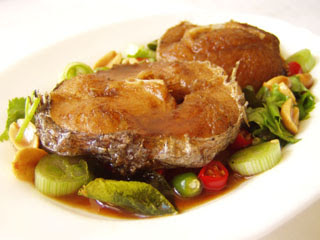
Ingredients
1 teaspoon coriander seed
1 teaspoon cumin seed1 tablespoon chopped garlic
1 tablespoon fresh grated ginger1 pound chicken breasts, skinned, boned, and cut into bite sized pieces.
2 tablespoons fish sauce
1 tablespoon curry powerpinch turmeric powderas only a colorant, so very little!8 tablespoons coconut milk
3 tablespoons plam sugar
Thai Cooking Instructions
The chicken is beaten flat, using the flat of the blade of a heavy cleaver or using a meat tenderizing mallet. You can also use a rolling pin.The coriander and cumin are toasted and then crushed in a mortar and pestleThe ingredients are then combined to form a marinade, and the chicken is marinated overnight. The pieces of chicken are then threaded on the 10” satay sticks, loosely folding them in half and piercing through the folded meat to forma loose gather.The completed sticks are then grilled, broiled or barbequed on fairly high heat (they taste best done over charcoal, as they absorb the smoke). Turn them regularly and brush them liberally with the remaining marinade.Cooking should take between 5 and 10 minutes depending on the heat of your cooker.
1 teaspoon coriander seed
1 teaspoon cumin seed1 tablespoon chopped garlic
1 tablespoon fresh grated ginger1 pound chicken breasts, skinned, boned, and cut into bite sized pieces.
2 tablespoons fish sauce
1 tablespoon curry powerpinch turmeric powderas only a colorant, so very little!8 tablespoons coconut milk
3 tablespoons plam sugar
Thai Cooking Instructions
The chicken is beaten flat, using the flat of the blade of a heavy cleaver or using a meat tenderizing mallet. You can also use a rolling pin.The coriander and cumin are toasted and then crushed in a mortar and pestleThe ingredients are then combined to form a marinade, and the chicken is marinated overnight. The pieces of chicken are then threaded on the 10” satay sticks, loosely folding them in half and piercing through the folded meat to forma loose gather.The completed sticks are then grilled, broiled or barbequed on fairly high heat (they taste best done over charcoal, as they absorb the smoke). Turn them regularly and brush them liberally with the remaining marinade.Cooking should take between 5 and 10 minutes depending on the heat of your cooker.

SpicyPeanut Sauce
Ingredients
4 ounces of roasted (unsalted) peanuts
3-4 cloves garlic, chopped1 ounce chopped onion
1-2 tablespoon red or massaman curry paste
1 teaspoon fish sauce
8 tablespoons coconut milk
4-6 teaspoons lime juice
2-3 teaspoons palm sugar
Thai Cooking Instructions
First grind or crush the peanuts to a fairly fine powder. Then combine them with the remaining ingredients(except the lime juice), to form a smooth sauce. If the sauce is too thick, you can thin it with a little chicken stock. Now add the lime juice, tasting as you progress to check the balance of flavors is correct.

cucumber sauce
Ingredients
4 tablespoons white vinegar
1 teaspoon sugar
2-3 tablespoons cucumber, very coarsely chopped or sliced
2 shallots (or any variety of purple onion) chopped
3-4 Thai chilies peppers, thinly sliced.

































































